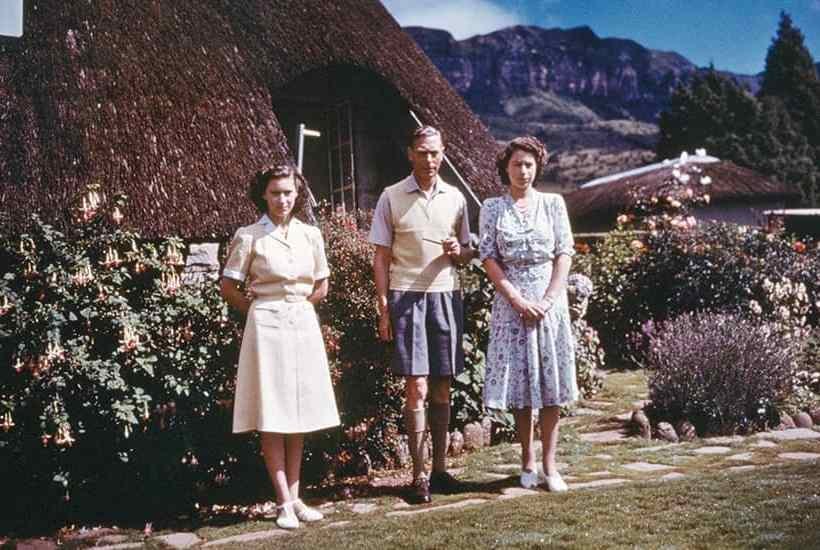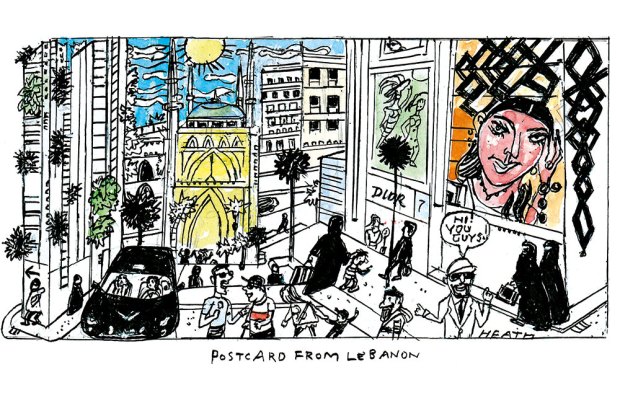Princess Elizabeth was 25 when her father died. She was on the first leg of a Commonwealth tour and she spent the night of 5 February 1952 at Treetops Hotel, set in the branches of a large fig tree in Aberdare National Park in Kenya. ‘For the first time in the history of the world,’ wrote the British naturalist Jim Corbett, who was a guest at the hotel at the same time, ‘a young girl climbed into a tree one day a princess and, after having what she described as her most thrilling experience, she climbed down from the tree next day a Queen.’
As interest in Queen Elizabeth II redoubles in the months leading up to the Platinum Jubilee celebrations in June, it is worth reflecting upon the formative years which prepared her for the moment of her accession, 70 years ago this week.
There is a telling vignette from early 1937 recorded by a governor-general’s lady at Sandringham. Princess Elizabeth was then almost 11. Complimented on his daughters by Alice Duncan, the new King confided in her that, as far as he could tell, his children had never known a moment’s fear in their lives — ‘very different’, he added, ‘to ourselves’, meaning himself and his siblings.
This perhaps is the key. In contrast to generations of Hanoverian monarchs who felt an antipathy for their heirs, this was a loving and nurturing home environment which enabled King George VI and Queen Elizabeth to lead, as they wished, by example.
Until she turned 21, the chief influences in the present Queen’s life were therefore her parents; her grandmother, Queen Mary; her governess, Marion Crawford; and Henry Marten, the vice-provost of Eton.
She was blessed with attractive looks, and old courtiers early detected something of Queen Victoria in the way she comported herself. The King delightedly said of his eldest: ‘Lilibet is my pride.’ She in turn was devoted to him, having inherited his steady, honourable character of quiet simplicity. They were close. As a teenager, she was his constant companion in shooting, walking and riding — in fact in everything, as Lady Airlie noted.
A devotion to duty was the virtue that her parents prized most. In her father’s case this was further burnished by his having had to overcome a private reluctance to fulfil the role thrust upon him by his brother’s abdication.
Next, the King was by nature egalitarian and progressive (or at least a royal version of those concepts) in his political thought. Eleanor Roosevelt spotted this: ‘I think he feels things more than she [his consort] does and knows more.’ Evelyn Baring, the British High Commissioner, saw him as the apotheosis of the ordinary man. He had grown wise in kingship and proved an excellent constitutional monarch — the model and guide to constitutional sovereigns throughout the world today and also to future generations, as Winston Churchill would put it in his eulogy. No one could possibly doubt that this had required a subtle touch. It was a skill he was able to pass to his heir.
Her mother would provide her with her strong religious faith and moral compass. Queen Elizabeth was an aristocratic traditionalist whose toughness was concealed by an immense charm and a vivid personality. These traits came together with the inherited skills to build a happy family life. Royal Lodge deliberately recreated Glamis Castle, not York Cottage, Sandringham. ‘It’s her court and household,’ observed Lady Diana Cooper.
George VI and Queen Elizabeth’s new court broke the mould, but not the seriousness of purpose. It was akin to that of a Scottish house party, as guests noted, with equestrian and blood sports, big teas and grog trays, parlour games after dinner and much laughter. It provided an upbeat background to what for most would be an intolerable life sentence. ‘We realise the big responsibility that has now fallen on our daughter’s shoulders,’ Queen Elizabeth confided to a stranger at the dinner following Princess Elizabeth’s 21st-birthday broadcast from Cape Town. ‘Still, as a family, we enjoy things so, and have the saving gift of laughter that lightens any burden.’
The Princesses’ nanny and nursery maid (later dresser and confidant) had been chosen from the formidable Scottish Presbyterian lower-middle classes, and came with a no-nonsense, get-on-with-it approach with which the Duchess of York was comfortable.
Similarly, Marion ‘Crawfie’ Crawford, the lively, 22-year-old Moray House graduate, was engaged as the Princesses’ governess on an aunt’s recommendation. This would create unanticipated problems once George VI became King. Despite Crawfie’s best efforts, the princesses were being brought up as ladies, their mother conforming to an aristocratic type who lived in horror of a daughter turning out to be a bluestocking. To marry well, manage their large houses and bring up Christian children to have, like them, good habits and good manners towards guests, servants and animals, was the general idea.
Appealed to by Miss Crawford, Queen Mary, who had had a hand in the initial curriculum, was privately appalled by her daughter–in-law’s lackadaisical attitude to the education of the Heiress Presumptive and her younger sister. Morning lessons were frequently interrupted, and afternoons directed to be set aside for exercise, fresh air and fun, together with a little light reading.
Tensions mounted, but Queen Elizabeth, something of an autodidact whose mind fascinated many clever men, was unrepentant. ‘My sisters and I had little formal education and all of us married well,’ she would say airily to those within her circle, adding after a slight pause, ‘in fact you could say that one of us married very well indeed.’
The solution was found in Sir Henry Marten, later provost of Eton, to whom the future monarch went for lessons in history, Bagehot and the British constitution. Marten, who had narrowly missed being made master of Magdalene College, Cambridge, taught her that the English monarchy, extending back to King Egbert, was exceeded in antiquity only by the papacy.
The first of the two great events affecting it in their own time, he believed, was the 1931 Statute of Westminster, which rendered a common allegiance to the Crown the sole surviving link between Britain and her Dominions. The second was broadcasting, which enabled the monarch to sustain that link.
Princess Elizabeth’s experiences on her post-war tour to South Africa, her first trip aboard, were influential too. ‘South Africa is in my blood,’ the present Queen has remarked in old age. There, in 1947, the charm offensive to repair the bonds of empire was successful. The royal family were presented as the embodiment of the values which most people would like for themselves — courage and determination shown in wartime, faith and simplicity, and a happy family life.
Far less successful were the royal family’s gentle prods that segregated white South Africans might do well to consider embracing the advancement of their fellow non-white inhabitants. This brought the King and his daughter face to face with complex issues of race relations — problems which were certain to assume increasing importance in the years ahead in many countries which owed allegiance to the Crown.
The tour also brought Princess Elizabeth into almost hourly contact with Sir Alan Lascelles, the King’s brilliant private secretary. He came from a tough school. If Marten had taught that the secret to the monarchy’s survival was to adapt, Lascelles sternly went one further. To survive in the 20th century, he believed, monarchs had to keep a pact with their subjects, to abide by the rules of conduct expected from them. It was another lesson well learnt.
During those sunny South African months, many strands of the Princess’s formative years had been conjoined. She came of age in more ways than one. Her 21st–birthday broadcast (written by Dermot Morrah but greatly rewritten in two hours by the King, Queen, Princess and the BBC’s Frank Gillard) suggests an adult mind clearly formed, and one which had seen a way forward for her life of duty as sovereign, not only of Britain but of a multiracial Commonwealth. There she made the vow to serve it, ‘whether my life be long or short’.
She has never wavered from that vow. Her motive might be said to have been a good daughter and successor to her father. And so she has been.
Got something to add? Join the discussion and comment below.
Get 10 issues for just $10
Subscribe to The Spectator Australia today for the next 10 magazine issues, plus full online access, for just $10.
You might disagree with half of it, but you’ll enjoy reading all of it. Try your first month for free, then just $2 a week for the remainder of your first year.














Comments
Don't miss out
Join the conversation with other Spectator Australia readers. Subscribe to leave a comment.
SUBSCRIBEAlready a subscriber? Log in